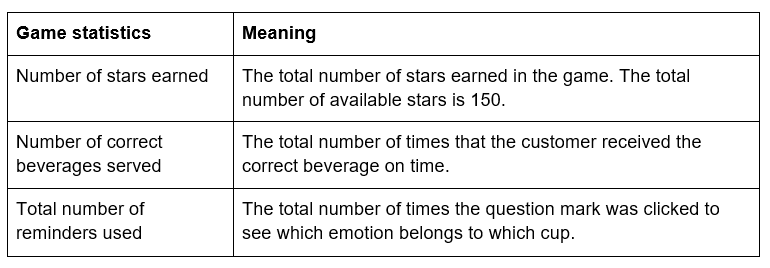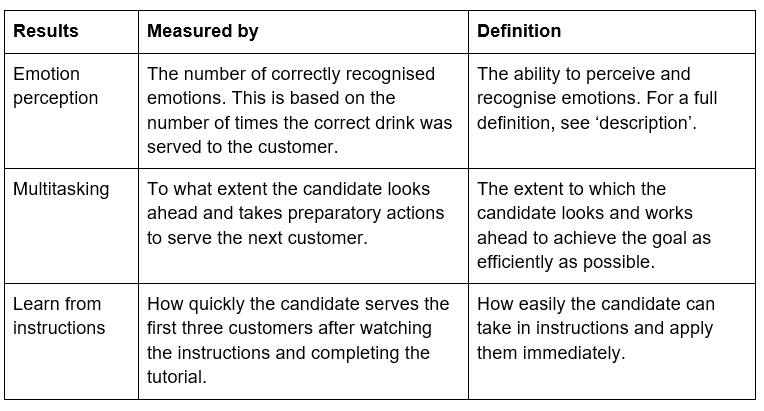Factsheet Psychometric Game ‘Barista’
‘Barista’ is a psychometric game. A psychometric game combines a psychometric test with game technology.
Description
‘Barista’ is a psychometric game. A psychometric game combines a psychometric test with game technology. It measures a psychological construct such as an individual skill, capacity or property. Scientifically robust methods are used to measure the construct.
The ‘Barista’ game is based on the ‘Facial Expression Recognition Task’ neuropsychological test. This task is used by scientists to measure emotion perception. Game elements are added to the neuropsychological test to motivate and enthuse candidates. The candidate is absorbed in playing the game (this is referred to as ‘flow’) and is therefore less aware of the assessment element. The game results thus better reflect the candidate’s best performance. A big advantage of using a game is that it improves the candidate experience. Using a game and game technology also means that we can measure emotion perception more accurately, thus enabling us to collect a greater amount of data in a shorter period of time.
Measurement pretensions
The ‘Barista’ game measures emotion perception. Emotion perception entails the perception and recognition of emotions. By recognising emotions in others, people know how another person is feeling and can use that information to respond appropriately. Emotion perception therefore plays an important role in social contact.
Emotion perception is an important element of emotional intelligence. Today there is still no consensus on what emotional intelligence entails. Most definitions see it as the quality or ability of an individual to recognise, express, understand and manage emotions in themselves and in others in order to deal with emotions as effectively as possible (Mayer, Roberts & Barsade, 2008; Van Rooy, Viswesvaran, & Pluta 2004; Zeidner, Roberts, & Matthews, 2008). The perception of emotions is therefore a crucial building block in emotional intelligence. People observe emotions in others through verbal and non-verbal behaviour. Facial expression is essential for the non-verbal communication of emotions. The ‘Barista’ game thus focuses on the emotional recognition of facial expressions.
Use
The ‘Barista’ game can be applied to all contexts, both selection and advisory, in which emotion perception is important. The ability to recognise emotions in others is important in professions in which the emphasis is on interpersonal contact. For example in sales, in management positions or in positions within the social services.
Development
This game is based on the ‘Facial Expression Recognition Task’ neuropsychological test. Game elements such as graphics, levels, rewards and feedback have been added to the test.
Photos of facial expressions
A database of 124 photos of faces expressing the five basic emotions (anger, sadness, joy, fear and disgust) and neutral was created for the game. Based on research, only those photo pairs were selected in which the research participants agreed about the emotion shown. A photo pair was comprised of a person expressing an emotion in one photo and a neutral facial expression in the other. Using a photo morphing programme, new photos with a variable emotional intensity were then generated (160 photos). These were shown to 64 research participants. 54 photos were selected for the game, based on agreement about the emotion shown and its intensity.
Game development
The first version of the game was tested in three qualitative pilot studies. Both the design and content of the game were improved based on the study participants’ feedback and experience. A usability study was also carried out to ensure that the game was in line with the target group, the general Dutch workforce. User experience and game interpretation were analysed by conducting interviews (thinking-out-loud and probing interviews) with people (N = 23) from various cultural backgrounds, educational levels, age, and game and computer experience. The results of this study formed the basis of improvements to the game and the tutorials, thus making the game accessible to everybody.
Reference group
The current reference group is based on data collected from research. This sample (N = 172) is representative of the Dutch labour force in terms of work situation (working or not working), gender, age and educational level.
How to read the report
The report gives the results of all the games that the candidate has completed. The report begins with a summary. The summary gives an outline of the results of all the games completed. Per game, the statistics and results are then explained in more detail. This fact sheet provides an explanation of the results of the ‘Barista’ game. For an explanation of the results of other games, see the Psychometric Game, ‘Blocks’, ‘Connect’ and ‘Rally’ fact sheets.
Summary
This shows the overall performance of each game. Performance is expressed as a sten score.

Game statistics
The game statistics provide general information about how well the game was played. The following game statistics are reported for the ‘Barista’ game:

Results
The results provide information about characteristics based on how the game was played. The results are expressed as sten scores. Sten scores are standard scores with an average of 5.5 and a standard deviation of 2. Sten scores show how the candidate’s scores relate to the reference group. Which results are reported, how these are measured and their definitions are shown below.

References
Mayer, J., Roberts, R. D., & Barsade, S. G. (2008). Human abilities: Emotional intelligence. Annual Review of Psychology, 59, 507–536.
Van Rooy, D. L., Viswesvaran, C., & Pluta, P. (2005). An evaluation of construct validity: What is this thing called emotional intelligence. Human Performance, 18, 445–462. 10.1207/s15327043hup1804_9.
Zeidner, M., Roberts, R. D., & Matthews, G. (2008). The science of emotional intelligence: Current consensus and controversies. European Psychologist, 13, 64–78.
